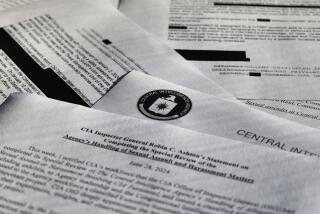The Stasi Files
WASHINGTON — It had begun in 1989 when a few hundred East Germans took to the streets, then tens of thousands, their ranks swelling to half a million in Leipzig, until finally, the Berlin Wall came tumbling down in November. Less than a year later, the German Democratic Republic was history.
Markus Wolf, the legendary spymaster who for 34 years headed the foreign intelligence arm of the Stasi, East Germany’s secret police, had to flee. As the government collapsed, the Stasi’s spy files were spirited out of the espionage agency’s headquarters on East Berlin’s Normannenstrasse for safekeeping. It was widely believed in Germany that the files went to Karlshorst, the KGB complex in East Berlin.
There they remained, even after the collapse of the Soviet Union in 1991. Sometime the following year, certainly by 1993, the Central Intelligence Agency got the files. Exactly how is something that the CIA won’t talk about; the operation is still extremely sensitive. Presumably, it had help from an insider, an agent in place. But the Stasi spy files, according to intelligence sources here, now reside at CIA headquarters in Langley, Va.
That fact must send chills through anyone who spied for the Stasi or its parent, the KGB. The files certainly were a major factor in the arrest last week of three Americans, including a woman lawyer who had worked at a fairly high level in the Pentagon, her husband and a friend. All three were charged with conspiracy to commit espionage and face possible life imprisonment.
The unprecedented access by Washington officials to the files of what had been a rival intelligence service also opens a window to understanding the past and the intrigues of the Cold War era. That knowledge may help to bring about a much-needed reappraisal of the role of U.S. intelligence in a changed world, in which old enemies have disappeared and new challenges, such as terrorism, international crime and nuclear proliferation have emerged.
The FBI, in its massive gathering of evidence in the latest case, found something equivalent to gold in the world of counterintelligence. In those Stasi files, it discovered “true name cards” for all three defendants, Theresa Marie Squillacote, 39, code-named “The Swan”; her husband, Kurt Alan Stand, 42, code-named “Junior,” and their friend, James Michael Clark, 49, alias “the Professor.” Intelligence agencies go to great lengths to protect the true names of their agents, but even spymasters have to know whom they have recruited. So somewhere there has to exist supersecret documents giving real names. Normally, counterintelligence investigators would not have access to such highly protected files. But because of the special circumstances surrounding the Stasi files, they did. The FBI was also able to interview former Stasi officers, some of whom provided information about the three suspects.
The FBI, it can be safely assumed, is not limiting its analysis of the Stasi files to the three defendants in the latest case. Although officials are cautious about making predictions, the likelihood is that there will be more such cases. Moreover, since the collapse of the communist governments of Eastern Europe and the Soviet Union, there has been a substantial traffic of defectors to the West. Some have provided leads to the FBI that are still being followed.
It was a former Soviet diplomat, for example, who provided the tip that led to the downfall of one of the FBI’s own counterintelligence agents, Earl Edwin Pitts, who was convicted of spying for Moscow and sentenced in June to 27 years in prison. Earlier this year, Raymond Mislock, the chief counterspy in the FBI’s Washington Field Office, confirmed that the bureau was investigating about 200 active espionage cases.
What all this suggests is that there will continue to be fallout from the legacy of the Cold War, as intelligence agencies here and abroad tidy up loose ends and pursue cases of spies who might have thought their actions would never be uncovered. John F. Lewis Jr., the assistant director of the FBI in charge of its National Security Division, noted that some East German officers “continued to run their agents well after the fall of the East German regime.” Lewis added: “Despite the end of the Cold War, there remains a significant threat to national security by those who are willing to spy against the U.S. for ideological reasons, as well as money.” Several arrests of spies over the past year, he said, “make it unfortunately clear that there will always be some Americans” who spy on their own country. “We will continue to improve our ability to identify them as quickly as possible and bring them to justice.”
The 200-page FBI affidavit filed in the latest case reads like a John le Carre spy novel with a touch of “Saturday Night Live” thrown in. The document tells the following tangled tale:
The three defendants are all described as campus radicals who met at the University of Wisconsin in Milwaukee in the 1970s. Although their motivation appears to have been primarily ideological, the trio accepted money from the Stasi, as much as $40,000 in one four-year period. Stand was recruited by his father, who had emigrated from Germany. In 1965, as a boy of 10, he was sent to a summer camp in East Germany. Stand, who began spying for the Stasi in 1972, recruited Clark four years later, and then Squillacote, whom Stand married in 1980.
Through Squillacote, the affidavit goes on to allege, the Stasi penetrated the House Armed Services Committee, where she worked on the staff briefly in 1990-91. She then moved to the Pentagon where, for six years, until early this year, she held various jobs, ending up as a senior staff attorney in the office of the deputy undersecretary of defense that deals with procurement reform. Clark, who was employed as a private investigator when he was arrested, worked for the Army for a time and for a defense contractor, a job that gave him access to classified data about nerve gas at the Rocky Mountain Arsenal near Denver. In 1980, he tried and failed to join the CIA. But he appears to have obtained most of his secret documents from two State Department friends, a woman, and a man who used to get together with him to smoke marijuana.
In 1989, during a security review, the State Department man confessed to authorities that he had passed classified documents to Clark. He claimed he thought he was just helping his friend to write research papers. It was the first early-warning light in the case, some six years before it grew into a full-scale FBI investigation. One defendant tried to penetrate the White House itself. As recently as last month, Squillacote applied for a job in the national-security section of the White House Office of Management and Budget, a post that, she wrote in a letter, “would be a very good stepping stone to the National Security Council.”
The key German case officer, the affidavit continues, was one Lothar Harri Ziemer, code-name “Harry,” who emerges from the pages of the FBI’s deadpan, Jack Webb-like prose as a sort of desperate, seedy character worthy of “The Third Man,” the classic spy movie set in postwar Vienna. But Harry Ziemer was no Harry Lime.
He fell in love with his agent--literally. Or as the FBI put it delicately, Squillacote had “a personal, intimate relationship with Ziemer.” But romance can be difficult; Squillacote complained at one point that Ziemer had “flipped me the bird.”
The collapse of East Germany left Ziemer and his spy network high and dry. Who would they spy for now? Ziemer, the FBI said, tried like a beaver to sell his network to Moscow, but the KGB wasn’t buying. It wasn’t about to trust a group of spies recruited by its now-defunct client state. Living in near-poverty, Ziemer was arrested and convicted of espionage in Germany two years ago.
In 1995, deprived of a country to spy for, Squillacote, using a false name, wrote to a South African official who was a leader of that country’s Communist Party, offering her services. The official wrote back a polite but noncommittal letter. The FBI learned of Squillacote’s letter and ran a “sting” operation against her, with a bureau agent posing as a South African intelligence officer. Squillacote boasted of her spying, explaining all sorts of details, including how she got instructions by short-wave radio from Havana.
The FBI ran a similar “false flag” operation against Clark, with an agent posing as a Russian. Clark was suspicious when he met the FBI man in a motel room in Falls Church, Va., and handed him a note that said: “I thought you were an FBI agent trying to set me up.” Despite his reservations, Clark then proceeded to babble in excruciating detail about his spying for East Germany, as the FBI’s recorders whirred. In a series of meetings with the fake Russian, Clark told how he sewed secrets inside dolls and hollow books, photographed documents on microfilm and traveled the world for meetings with the Stasi. He said that around the time East Germany collapsed, he tried to destroy the evidence of his espionage by smashing a miniature camera repeatedly with a hammer. When the darn thing wouldn’t break apart, he threw it in the Potomac.
Espionage is a very difficult crime to prove, because the FBI is usually not on hand when a document is actually passed. For that reason, even finding the true names of spies in the Stasi files was not enough. Intelligence officers often puff up their importance with headquarters by listing people as agents who may simply have sounded sympathetic at a cocktail party. So the FBI tries to get suspected spies to admit what they did, either when they are interviewed, or through sting operations, as in this case.
The bureau bugged and wiretapped the suspects and often overheard Clark talking to himself, once muttering: “Gonna say you’re a spy . . . spy . . . spy . . . You work for the KGB!” Another time, Clark was recorded saying “. . . ah, FBI, you’re under arrest.” As it turned out, he was right.
More to Read
Sign up for Essential California
The most important California stories and recommendations in your inbox every morning.
You may occasionally receive promotional content from the Los Angeles Times.










